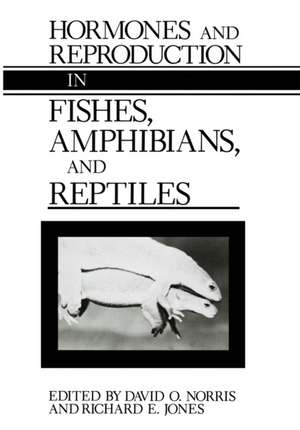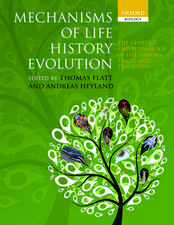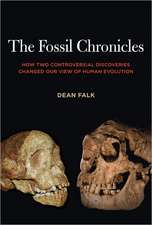Hormones and Reproduction in Fishes, Amphibians, and Reptiles
Editat de David O. Norris, Richard E. Jonesen Limba Engleză Paperback – 9 noi 2011
Preț: 804.66 lei
Preț vechi: 981.29 lei
-18% Nou
Puncte Express: 1207
Preț estimativ în valută:
153.99€ • 160.18$ • 127.13£
153.99€ • 160.18$ • 127.13£
Carte tipărită la comandă
Livrare economică 15-29 aprilie
Preluare comenzi: 021 569.72.76
Specificații
ISBN-13: 9781461290421
ISBN-10: 1461290422
Pagini: 640
Ilustrații: XXV, 613 p.
Dimensiuni: 178 x 254 x 34 mm
Greutate: 1.09 kg
Ediția:Softcover reprint of the original 1st ed. 1987
Editura: Springer Us
Colecția Springer
Locul publicării:New York, NY, United States
ISBN-10: 1461290422
Pagini: 640
Ilustrații: XXV, 613 p.
Dimensiuni: 178 x 254 x 34 mm
Greutate: 1.09 kg
Ediția:Softcover reprint of the original 1st ed. 1987
Editura: Springer Us
Colecția Springer
Locul publicării:New York, NY, United States
Public țintă
ResearchDescriere
Comparative endocrinology is one of the most rapidly developing subdis ciplines within the field of endocrinology, and it is having a significant impact on research at the molecular, cellular, organisma1 and environmental levels. Much of the current ferment in endocrinology is in reproductive endocrinology. The purpose of this volume on hormones and reproduction in fishes, amphibians and reptiles is to summarize our present understandings and to identify important research problems to be addressed in the area of comparative reproductive endocrinology. It was inspired by the gathering at Copper Mountain, Colorado, of eminent endocrine scientists from around the world on the occasion of the Tenth International Symposium on Comparative Endocrinology in July, 1985. While preparing for that meeting, we decided that a special volume on reproductive endocrinology was needed to summarize what is known and to stimulate research in particular directions. Why do we emphasize fishes, amphibians and reptiles? First, knowledge about the reproductive endocrinology of these ectothermic vertebrates can provide a clearer picture of the evolution of reproductive hormones and their effects on target organs. This comparative approach can lead to new theories about the evolution of reproductive control mechanisms. Second, studies concerning the reproductive endocrinology of "lower" vertebrates can result in development of "model systems" for application to studies of birds and mammals. Indeed, information about the patterns of reproductive control in ectothermic vertebrates can tell us which are evolutionarily stable and which are labile.
Cuprins
1 Hormones and Sexual Differentiation.- I. Introduction.- A. Sex Determination.- II. Theoretical and Conceptual Context.- A. Organization vs. Activation: Critical Periods.- B. Adult Sexual Dimorphism.- C. The Nature of the Inducer(s).- III. Differentiation of the Gonads.- A. Fishes.- B. Amphibians.- C. Reptiles.- IV. Differentiation of Other Reproductive Structures.- A. Fishes.- B. Amphibians.- C. Reptiles.- V. Differentiation of Behavior and the Nervous System.- A. Fishes.- B. Amphibians..- C. Reptiles.- VI. Temperature and Sexual Differentiation.- VII. Environmental Hermaphroditism and Social Influences on Sexual Differentiation.- A. Fishes.- VIII. Summary and Conclusions.- A. The Nature of the Inducer(s).- B. How Useful is the Organizational Theory?.- C. Relationship Between Sex Determination and Differentiation..- D. Differentiation and Epigenesis.- IX. Acknowledgments.- X. References.- 2 Gonadotropin-Releasing Hormones in Fishes.- I. The primary Structure of Known GnRH Family Members.- A. Overview of Mammals and Birds.- B. Fishes.- C. Amphibians and Reptiles.- II. Characterization of New GnRH Molecules in Fishes.- A. Agnatha.- B. Chondrichthyes.- C. Osteichthyes.- 1. Nonteleosts.- 2. Teleosts.- III. Anatomical Location of GnRH in Fish Brain.- A. Agnatha.- B. Chondrichthyes.- C. Osteichthyes.- IV. Reproductive Responses to GnRH.- A. Agnatha.- 1. Gonadotropins (Gns).- 2. Steroids.- 3. Ovulation..- B. Chondrichthyes.- 1. Gonadotropins.- 2. Steroids.- 3. Ovulation.- C. Osteichthyes: Nonteleosts.- 1. Gonadotropins.- 2. Steroids.- 3. Ovulation.- D. Osteichthyes: Teleosts.- 1. Gonadotropins.- 2. Steroids.- 3. Ovulation and Spawning.- V. Summary and Future Research Directions.- A. Evolution of the GnRH Family.- B. The Primary Structure of GnRH in Other Fishes.- C. Multiple Forms of GnRH in Single Species of Fish.- D. Other Roles for GnRH in Fishes.- E. Inhibitory Effects of GnRH.- F. A Possible GnRIF.- G. The Nature of Fish GnRH Receptors..- H. The Fish GnRH Precursor(s).- VI. Acknowledgments.- VII. References.- 3 Role of Gonadotropin-Releasing Hormone in Regulation of Gonadotropin Secretion from Amphibian and Reptilian Pituitaries.- I. Identification and Chemical Characterization of GnRH.- A. Amphibians.- 1. Changes in Endogenous GnRH.- 2. Biochemistry of GnRH.- B. Reptiles.- 1. Biochemical Characterization.- II. Regulation of Pituitary Gonadotropin Release: In vivo studies.- A. Amphibians.- B. Reptiles.- III. In vitro Characterization of Pituitary Responsiveness to GnRH.- A. Amphibians.- B. Reptiles.- IV. Mechanism of Action of GnRH.- V. Future Research Directions.- VI. Acknowledgment.- VII. References.- 4 Prolactin and Reproduction.- I. Prolactin Receptors.- A. Overview of Mammals.- B. Fishes.- C. Amphibians.- D. Reptiles.- II. Effects of Prolactin on Gonads, Sexual Accessories and on Secondary Sexual Characters.- A. Overview of Mammals.- B. Fishes.- C. Amphibians.- D. Reptiles.- III. Prolactin and Adaptations to the Reproductive Environment.- A. Overview of Mammals.- B. Fishes.- C. Amphibians.- D. Reptiles.- IV. Prolactin and Reproductive Behavior.- A. Overview of Mammals.- B. Fishes.- 1. Migration.- 2. Sexual Behavior.- 3. Parental Behavior.- C. Amphibians.- 1. Water Drive.- 2. Sexual Behavior.- 3. Parental Care.- D. Reptiles.- V. Summary and Future Research Directions.- VI. References.- 5 Regulation of Ovarian Steroidogenesis.- I. Introduction.- II. Overview of Mammals.- III. Ovarian Morphology.- A. Cyclostomes.- B. Elasmobranchs.- C. Teleosts.- D. Amphibians.- E. Reptiles.- IV. Sites of Steroidogenesis.- A. Cyclostomes.- B. Elasmobranchs.- C. Teleosts.- D. Amphibians.- E. Reptiles.- V. Steroid Identification and Biosynthesis.- A. Cyclostomes.- B. Elasmobranchs.- C. Teleosts.- D. Amphibians.- E. Reptiles.- VI. Seasonal Profiles.- A. Cyclostomes.- B. Elasmobranchs.- C. Teleosts.- D. Amphibians.- E. Reptiles.- VII. Gonadotropic Control of Folliculogenesis and Steroidogenesis.- A. Cyclostomes.- B. Elasmobranchs.- C. Teleosts.- D. Amphibians.- E. Reptiles.- VIII. Local Control of Steroidogenesis.- IX. Summary and Future Research Directions.- X. References.- 6 Endocrinology of Vitellogenesis.- I. Introduction.- II. Vitellogenin and Vitellogenin Genes.- A. Fishes.- B. Amphibians.- C. Reptiles.- III. Estrogen Stimulation of Vitellogenin Synthesis and Secretion.- A. Fishes.- B. Amphibians.- C. Reptiles.- IV. Estrogen Specificity in the Induction of Vitellogenin Synthesis.- A. Fishes.- B. Amphibians.- C. Reptiles.- V. Influence of Non-estrogenic Steroids on Vitellogenesis.- A. Fishes.- B. Amphibians.- C. Reptiles.- VI. Influence of Non-steroidal Hormones on Vitellogenesis.- A. Fishes.- B. Amphibians.- C. Reptiles.- VII. Other Non-hormonal Factors Regulating Vitellogenesis.- A. Fishes.- B. Amphibians.- C. Reptiles.- VIII. Endocrine Control of Vitellogenin Uptake by Oocytes.- A. Fishes.- B. Amphibians.- C. Reptiles.- IX. Summary of Future Research Directions.- X. References.- 7 Endocrine Control of Oocyte Maturation.- I. Introduction.- II. Primary Hormones Involved in Triggering Oocyte Maturation.- A. Overview of Mammals.- B. Fishes.- C. Amphibians.- D. Reptiles.- III. Maturation-inducing Substances.- A. Overview of Mammals.- B. Fishes.- C. Amphibians.- D. Reptiles.- IV. Maturation-promoting Factor.- A. Amphibians.- B. Others.- V. Maturation-inhibiting Substances.- A. Overview of Mammals.- B. Fishes.- C. Amphibians.- VI. Summary and Future Research Directions.- VII. Acknowledgments.- VIII. References.- 8 Ovulation: Insights about the Mechanisms Based on a Comparative Approach.- I. Introduction.- II. General Description of the Process of Ovulation.- A. Mammals and Birds.- B. Fishes.- C. Amphibians.- D. Reptiles.- III. Cellular Changes in the Follicular Wall Preceding its Rupture.- A. Mammals and Birds.- B. Fishes, Amphibians and Reptiles.- IV. Gonadotropins, Steroid Hormones and Ovulation.- A. Mammals and Birds.- B. Fishes.- C. Amphibians.- D. Reptiles.- V. Prostaglandins and Ovulation.- A. Mammals and Birds.- B. Fishes.- C. Amphibians and Reptiles.- VI. Enzymes and Ovulation.- A. Mammals and Birds.- B. Fishes.- C. Amphibians.- D. Reptiles.- VII. Follicular Contraction and Ovulation.- A. Evidence for a Role of Follicular Contraction in Ovulation.- 1. Mammals and Birds.- 2. Fishes.- 3. Amphibians.- 4. Reptiles.- B. Adrenergic and Cholinergic Effects on Follicular Contraction.- 1. Mammals and Birds.- 2. Teleostean Fishes.- 3. Amphibians and Reptiles.- C. Prostaglandins and Follicular Contraction.- D. Oxytocic Hormones and Follicular Contraction.- E. Follicular Wall Tension and Follicular Contraction.- VIII. Summary and Future Research Directions.- IX. Acknowledgments.- X. References.- 9 Functional Morphology and Regulation of the Corpus Luteum.- I. Introduction.- II. Formation and Morphology of the Corpus Luteum.- A. Overview of Mammals.- B. Fishes.- C. Amphibians.- D. Reptiles.- III. Hormone Production by the Corpus Luteum.- A. Overview of Mammals.- B. Fishes.- C. Amphibians.- D. Reptiles.- IV. Regulation of Corpus Luteum Activity (Luteotropic Factors).- A. Overview of Mammals.- B. Fishes.- C. Amphibians.- D. Reptiles.- V. Regression of the Corpus Luteum (Luteolytic Factors).- A. Overview of Mammals.- B. Fishes.- C. Amphibians.- D. Reptiles.- VI. Summary and Future Research Directions.- VII. Acknowledgments.- VIII. References.- 10 Testicular Function.- I. Introduction.- II. Testicular Structure.- A. Fishes.- B. Amphibians.- C. Reptiles.- III. The Spermatogenetic Cycle.- A. Cystic and Non-cystic Spermatogenesis.- B. Spermatogenetic Cyclicity.- 1. Fishes.- 2. Amphibians.- 3. Reptiles.- IV. Steroid Cycles.- A. Steroidogenesis.- 1. Fishes.- 2. Amphibians.- 3. Reptiles.- B. Interstitial Leydig Cells.- 1. Fishes.- 2. Amphibians.- 3. Reptiles.- C. Lobule Boundary Cells.- 1. Teleostean Fishes.- 2. Amphibians.- D. Sertoli Cells.- 1. Fishes.- 2. Amphibians.- 3. Reptiles.- V. Pituitary-Testis Interrelationships.- A. Fishes.- B. Amphibians.- C. Reptiles.- VI. References.- 11 Regulation of Male Gonaducts and Sex Accessory Structures.- I. Introduction.- II. Wolffian Ducts, Mesonephric Kidneys and Their Derivatives.- A. Fishes.- B. Amphibians.- C. Reptiles.- III. Mullerian Duct Development in Males.- A. Fishes.- B. Amphibians.- C. Reptiles.- IV. Derivatives of the Urogenital Sinus.- A. Fishes.- B. Amphibians.- C. Reptiles.- D. Birds.- V. Intromittant Organs.- A. Fishes.- B. Amphibians.- C. Reptiles.- D. Birds.- VI. Secondary Sexual Characters.- A. Fishes.- B. Amphibians.- C. Reptiles.- VII. The “Paradoxical” Action of Androgens.- VIII. Effects of Arginine Vasotocin on Genital Ducts.- IX. Summary and Future Research Directions.- A. Wolffian Duct, Mesonephric Kidneys and Their Derivatives.- B. Mullerian duct Development in Males.- C. Derivatives of the Urogenital Sinus.- D. Secondary Sexual Characters.- E. The “Paradoxical” Action of Androgens.- X. Acknowledgments.- XI. References.- 12 Sex Steroid Receptors and Non-Receptor Binding Proteins.- I. Mechanisms of Steroid Hormone Action: An Overview.- A. Genomic Mechanisms.- B. Nongenomic Mechanisms.- II. Receptors.- A. General Characteristics.- B. Phylogenetic Distribution.- C. Major Classes of Steroid Receptors.- 1. Androgen Receptors.- 2. Estrogen Receptors.- 3. Progesterone Receptors.- D. Receptors in Different Physiological States and Their Regulation.- 1. The Liver and Vitellogenesis.- 2. Gonadal Functions.- 3. Female Reproductive Tract.- 4. Neuroendocrine Tissues.- 5. Other Tissues.- III. Non-receptor Steroid-Binding Proteins (SBPs).- A. General Characteristics.- B. Phylogenetic and Tissue Distribution.- C. Functions.- D. Natural Changes and Regulation of SBPs.- IV. Summary and Future Directions.- V. Acknowledgments.- VI. References.- 13 Seasonal Reproduction; Patterns and Control.- I. Adaptiveness of Seasonality.- A. Costs of Reproduction.- 1. Fishes.- 2. Amphibians.- 3. Reptiles.- B. Relation of Reproductive Cycles to other Seasonal Cycles.- II. Patterns of Reproduction.- A. Timing of Reproduction.- 1. Fishes.- 2. Amphibians.- 3. Reptiles.- B. Synchrony and Regularity of Reproduction.- 1. Fishes.- 2. Amphibians.- 3. Reptiles.- III. Control of Seasonal Reproduction.- A. Pre-programmed (Closed) vs. Labile (Open) Control.- B. Endogenous Cycles.- 1. Fishes.- 2. Amphibians.- 3. Reptiles.- C. Environmental Control.- 1. Fishes.- 2. Amphibians.- 3. Reptiles.- IV. Neuroendocrine Control of Reproduction.- A. Mechanisms of Endogenous Control.- B. Mechanisms of Environmental Control.- 1. Fishes.- 2. Amphibians.- 3. Reptiles.- V. Summary and Directions for Future Research.- VI. Acknowledgments.- VII. References.- 14 Thyroid Hormones and Reproduction.- I. Introduction.- A. Control of Thyroid Function.- B. Interpretations of Observations.- C. Thyroid Function and Reproduction in Mammals.- II. Thyroid Hormones and Gonadal Functions.- A. Fishes.- B. Amphibians.- C. Reptiles.- III. Seasonal Changes in Thyroid Activity.- A. Fishes..- B. Amphibians.- C. Reptiles.- IV. Thyroid Hormones and Vitellogenesis.- A. Fishes.- B. Amphibians.- C. Reptiles.- V. Gonadotropins, Gonadal Steroids and Thyroid Economy.- A. Fishes.- B. Amphibians.- C. Reptiles.- VI. Summary and Future Research Directions.- VII. Acknowledgment.- VIII. References.- 15 Pineal Involvement in Seasonality of Reproduction.- I. Introduction.- II. Pineal and Reproduction.- A. Mammalian Overview.- B. Agnathans.- C. Teleosts.- D. Amphibians.- E. Reptiles.- 1. Males..- 2. Females.- III. Summary and Directions for Future Research.- IV. Acknowledgments.- V. References.- 16 Stress and Reproduction: Reciprocal Relationships.- I. Introduction.- A. Background.- B. Definitions.- C. Stress Hormones.- II. Stress Effects on Reproductive Physiology and Behavior.- A. Overview of Mammals.- 1. Effects of Stress upon Social and Reproductive Activity.- 2. Stress Axis Effects on Gonadal Function.- B. Fishes.- C. Amphibians.- D. Reptiles.- III. Effects of Reproductive Physiology and Behavior on Stress Responses.- A. Overview of Mammals.- B. Fishes.- C. Amphibians.- D. Reptiles.- IV. The Adaptive Significance of Gonadal-Adrenal Reciprocal Interactions.- V. Future Research Directions.- VI. Acknowledgments.- VII. References.- 17 Regulation of Reproductive Behaviors.- I. Female Reproductive Behaviors.- A. Teleostean Fishes: Females.- 1. Sexual Attractivity.- 2. Proceptive and Receptive Behaviors.- B. Amphibians: Females.- 1. Sexual Attractivity.- 2. Proceptive and Receptive Behaviors.- C. Reptiles: Females.- 1. Sexual Attractivity.- 2. Proceptive and Receptive Behaviors.- II. Male Reproductive Behaviors.- A. Teleostean Fishes: Females.- 1. Sexual Attractivity.- 2. Proceptive and Receptive Behaviors.- B. Amphibians: Males.- 1. Sexual Attractivity.- 2. Proceptive and Receptive Behaviors.- C. Reptiles: Males.- 1. Sexual Attractivity.- 2. Proceptive and Receptive Behaviors.- III. Behavioral Activation of Endocrine System.- A. Fishes: Behavioral Activation.- B. Amphibians: Behavioral Activation.- C. Reptiles: Behavioral Activation.- IV. Summary and Future Research.- V. References.- 18 The Evolution of Viviparity in Fishes, Amphibians and Reptiles: An Endocrine Approach.- I. Introduction and Terminology.- II. Viviparity in Fishes, Amphibians and Reptiles.- III. Gestation Maintenance and Early Placentation.- A. Chondrichthyan Fishes.- 1. Previous Research.- 2. Future Research Needs.- B. Bony Fishes.- 1. Previous Research.- 2. Future Research Needs.- C. Amphibians.- 1. Previous Research.- 2. Future Research Needs.- D. Reptiles.- 1. Previous Research.- 2. Future Research Needs.- IV. Acknowledgments.- V. References.- 19 Aging of the Neuroendocrine System.- I. Introduction.- A. Background.- B. The Platyfish (Xiphophorus maculatus; Poeciliidae): A Model to Study Aging.- II. Brain.- A. Birth to Sexual Maturity.- 1. Gonadotropin-releasing Hormone (GnRH).- B. Maturity to Senescence (8 to 30 months).- 1. GnRH in NOR.- 2. GnRH in NPP.- 3. GnRH in NLT.- 4. Serotonin (5HT).- 5. Tyrosine Hydroxylase (TH).- III. Pituitary Gland.- A. Birth to Sexual Maturity.- 1. Gn and GnRH.- B. Maturity to Senescence..- 1. Gn and GnRH: Ventral CPD.- 2. Gn and GnRH: Pars Intermedia.- 3. Serotonin.- 4. Tyrosine Hydroxylase.- IV. Gonads.- A. Birth to Sexual Maturity.- 1. Testis.- 2. Ovary.- B. Maturity to Senescence.- 1. Testis.- 2. Ovary.- V. Synthesis, Summary and Suggestions for Future Research Directions.- VI. Acknowledgments.- VII. References.- Contributors.- Species Index.







